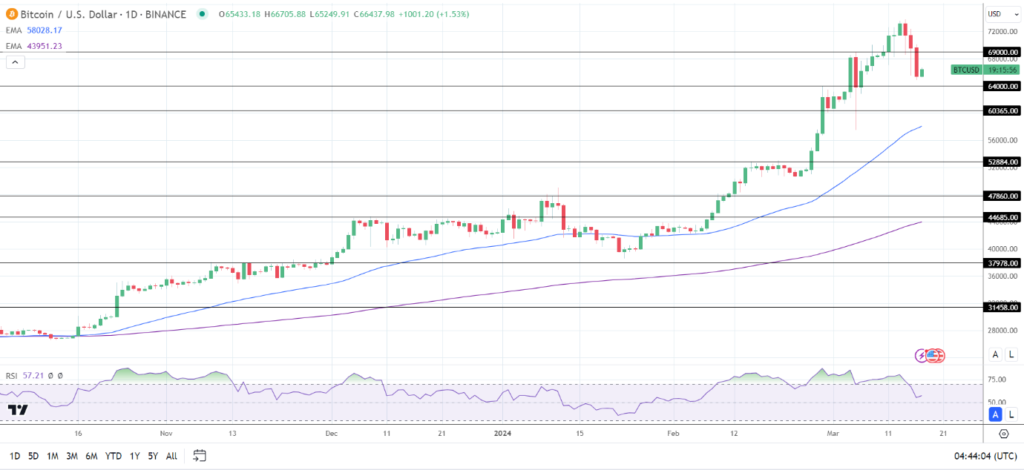BTC-Spot ETF Market Experiences a Decline in Net Inflows, Triggering a Downward Trend in BTC Value On Saturday, March 16, Bitcoin price (BTC) experienced a significant drop of 5.99%, closing the trading session at a value of $65,437.
The market flow data from the BTC-spot Exchange Traded Fund (ETF) on Friday, March 15, had a noticeable impact on the demand for BTC from buyers.
Specifically, the BTC-spot ETF market recorded net inflows of $338.2 million on Friday, excluding the outflows from the Grayscale Bitcoin Trust (GBTC). This marked a decrease from the net inflows (excluding GBTC outflows) of $389.8 million on Thursday, March 14, and $960.2 million on Wednesday, March 13.
An unexpected surge in U.S. producer prices on Thursday has influenced market predictions regarding a potential Federal Reserve rate cut in the first half of 2024. The year-on-year increase in producer prices was 1.6%, a significant rise from the 1.0% increase observed in January. This surpassed economists’ forecast of a 1.1% increase and followed the U.S. Consumer Price Index (CPI) report released on Tuesday, which indicated a persistently high inflation environment.
Data from the CME FedWatch Tool revealed a decrease in the likelihood of a 25-basis point rate cut in May, from 23.2% to 6.4%, for the week ending March 15. Concurrently, the probability of the Federal Reserve maintaining the interest rate at 5.50% in June increased from 26.6% to 41.2%.
This shift in market sentiment towards the Federal Reserve’s rate trajectory, coupled with its impact on the net inflows of the BTC-spot ETF market, contributed to Bitcoin’s value dipping to a low of $64,909 on Saturday.
However, despite this downturn, the total net inflows for the week ending March 15 reached a record-breaking $2,565.7 million. This surpassed the previous record of $2,271 million set in the week ending February 16. This data, which includes outflows from the Grayscale Bitcoin Trust (GBTC), could potentially provide price support on Sunday as investors contemplate the upcoming week.
The U.S. Federal Reserve is set to announce its decision on interest rates for March on Wednesday, March 20.
While investors anticipate that the rates will remain at 5.50%, the Federal Reserve’s forward guidance could sway near-term Bitcoin price trends.
The Federal Open Market Committee’s (FOMC) Economic Projections and Press Conference will be key events to watch. If concerns about inflation and the necessity for a prolonged period of higher Federal Reserve rates persist, Bitcoin could face downward pressure at its current levels.
Investors should also take into account the flow data from the BTC-spot ETF market. If the trend of increasing total net inflows continues, it could mitigate the effects of a more hawkish Federal Reserve.
On the other hand, if the Federal Reserve indicates support for a rate cut in the first half of 2024, it could stimulate demand for Bitcoin and potentially lead to a new all-time high.
Technical Analysis
Bitcoin (BTC) Analysis: Bullish Indicators and Key Resistance Levels

Bitcoin’s position above both the 50-day and 200-day Exponential Moving Averages (EMAs) underscores the prevailing bullish sentiment in the market.
Should Bitcoin break past the resistance level of $69,000, it would pave the way for a rally towards its all-time high (ATH) of $73,810, recorded on March 14. Surpassing this ATH could potentially propel Bitcoin towards the $75,000 mark.
Market discussions and perspectives on the Federal Reserve’s rate path, particularly within the BTC-spot ETF market, are crucial considerations for investors on Sunday.
However, a decline below the support level of $64,000 could indicate a potential downturn for Bitcoin, possibly driving its value towards the $60,365 support level.
The 14-day Relative Strength Index (RSI) reading stands at 57.21, suggesting that Bitcoin could revisit its ATH of $73,810 before entering the overbought territory.




